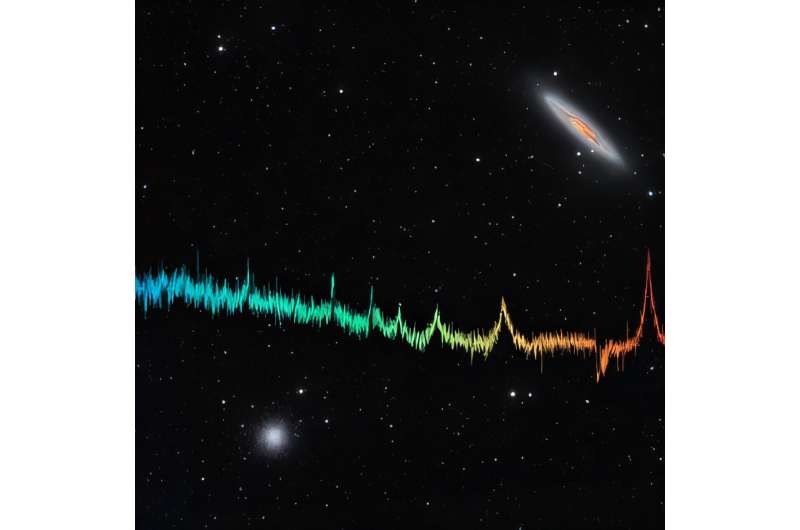Science
4MOST Telescope Achieves First Light, Unlocking New Cosmic Insights

On October 18, 2025, the 4-meter Multi-Object Spectroscopic Telescope (4MOST) facility successfully captured its first light at the European Southern Observatory’s (ESO) Paranal Observatory in Chile. This milestone marks a critical moment in the telescope’s development, indicating its readiness to embark on a scientific journey that promises to expand our understanding of the universe.
The 4MOST telescope is designed not only to take images but to record the spectra of celestial objects. This capability allows astronomers to dissect the light from 2,400 objects simultaneously into 18,000 color components. By doing so, 4MOST aims to investigate the formation and evolution of stars, planets, and galaxies, alongside other cosmic phenomena such as black holes and dark matter.
Once fully operational, 4MOST will conduct observations every 10 to 20 minutes. It is expected to compile an extensive catalogue detailing the temperatures, chemical compositions, and velocities of tens of millions of objects spread across the Southern sky. Such an ambitious undertaking establishes 4MOST as the largest multi-object spectroscopic survey facility in the southern hemisphere, uniquely characterized by its extensive field of view and the number of objects it can observe simultaneously.
Development of 4MOST began in 2010, with the facility designed to operate for at least the next 15 years. The Leibniz Institute for Astrophysics Potsdam (AIP) leads the consortium responsible for building and operating the telescope. Key developments include a wide field camera equipped with six lenses, advanced guiding and focusing systems, and a fiber system containing over 2,400 glass fibers, each no thicker than a human hair.
The Principal Investigator, Roelof de Jong, who heads the Milky Way section at AIP, expressed his enthusiasm: “It is incredible to see the first spectra from our new instrument. The data looks fantastic from the start and bodes well for all the different science projects we want to execute.” He emphasized the significance of capturing light that has traveled billions of years to reach the telescope.
Project Manager Joar Brynnel reflected on the achievement stating, “Reaching this milestone is a wonderful achievement after more than a decade of intensive efforts.” He highlighted the contributions of the entire team, acknowledging their dedication and commitment that exceeded expectations.
Science Director Matthias Steinmetz described the implications of 4MOST’s first light: “With the First Light of 4MOST, we are opening a new chapter in sky surveys. Its 2,436 optical fibers allow us to capture thousands of objects in the southern sky simultaneously.” The telescope will address fundamental questions regarding the formation of the Milky Way, the evolution of galaxies, and the forces shaping the universe.
Notably, one of the first objects observed was the elongated galaxy NGC 253, also known as the Sculptor or Silver Coin galaxy. Located approximately 11.5 million light years away, it is renowned for its active star formation. The initial observations also included a super star cluster and various other celestial phenomena.
During its first 20-minute science observation, 4MOST recorded spectra from over 2,000 objects, including a pair of overlapping galaxies located 900 million light years away. This data will help scientists determine distances, internal velocities, and star formation histories of these galaxies.
The science team comprises more than 700 researchers from various universities and institutions worldwide. In its first five years, 4MOST plans to undertake 25 different science programs, with ten designed by consortium members and the remaining selected by an external committee of astronomers.
4MOST’s innovative technology allows simultaneous observations, enabling diverse scientific inquiries. For example, while some fibers study rare objects, others can gather statistical samples of stars or galaxies. Highlighted research areas include the origins of chemical elements, the growth of the Milky Way, and the nature of dark energy.
The telescope employs a sophisticated system where light from each of the 2,436 optical fibers is transmitted to spectrographs that separate the light into various colors. With a field of view of 2.5 degrees, which is five times larger than the moon, 4MOST’s capacity for sky observation is among the largest globally for a telescope of its class.
As planning and execution of observations occur remotely from the Max Planck Institute for Extraterrestrial Physics in Garching, Germany, the European Southern Observatory is responsible for maintaining the instrument and executing the observations. The resulting data will be analyzed at the 4MOST data center at the University of Cambridge and subsequently archived at AIP and ESO for access by the scientific community.
The successful first light observation of the 4MOST telescope heralds a new era in astronomical research, promising profound insights into our universe and its myriad mysteries.
-

 Science2 months ago
Science2 months agoInventor Achieves Breakthrough with 2 Billion FPS Laser Video
-

 Health2 months ago
Health2 months agoCommunity Unites for 7th Annual Into the Light Walk for Mental Health
-

 Top Stories2 months ago
Top Stories2 months agoCharlie Sheen’s New Romance: ‘Glowing’ with Younger Partner
-

 Entertainment2 months ago
Entertainment2 months agoDua Lipa Aces GCSE Spanish, Sparks Super Bowl Buzz with Fans
-

 Health2 months ago
Health2 months agoCurium Group, PeptiDream, and PDRadiopharma Launch Key Cancer Trial
-

 Top Stories2 months ago
Top Stories2 months agoFormer Mozilla CMO Launches AI-Driven Cannabis Cocktail Brand Fast
-

 Entertainment2 months ago
Entertainment2 months agoMother Fights to Reunite with Children After Kidnapping in New Drama
-

 World2 months ago
World2 months agoR&B Icon D’Angelo Dies at 51, Leaving Lasting Legacy
-

 World2 months ago
World2 months agoIsrael Reopens Rafah Crossing After Hostage Remains Returned
-

 Business2 months ago
Business2 months agoTyler Technologies Set to Reveal Q3 Earnings on October 22
-

 Health2 months ago
Health2 months agoNorth Carolina’s Biotech Boom: Billions in New Investments
-

 Health2 months ago
Health2 months agoYouTube Launches New Mental Health Tools for Teen Users









